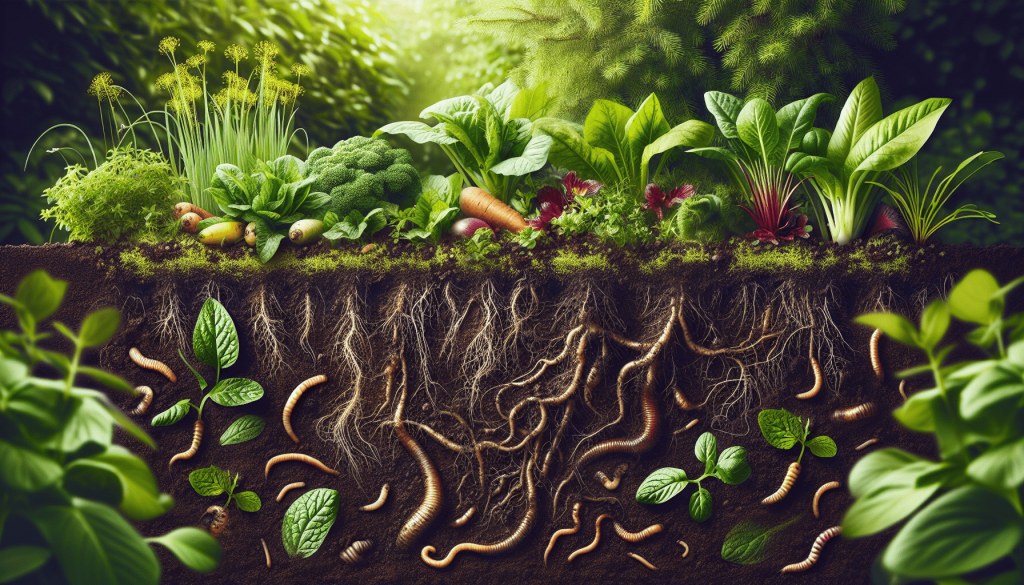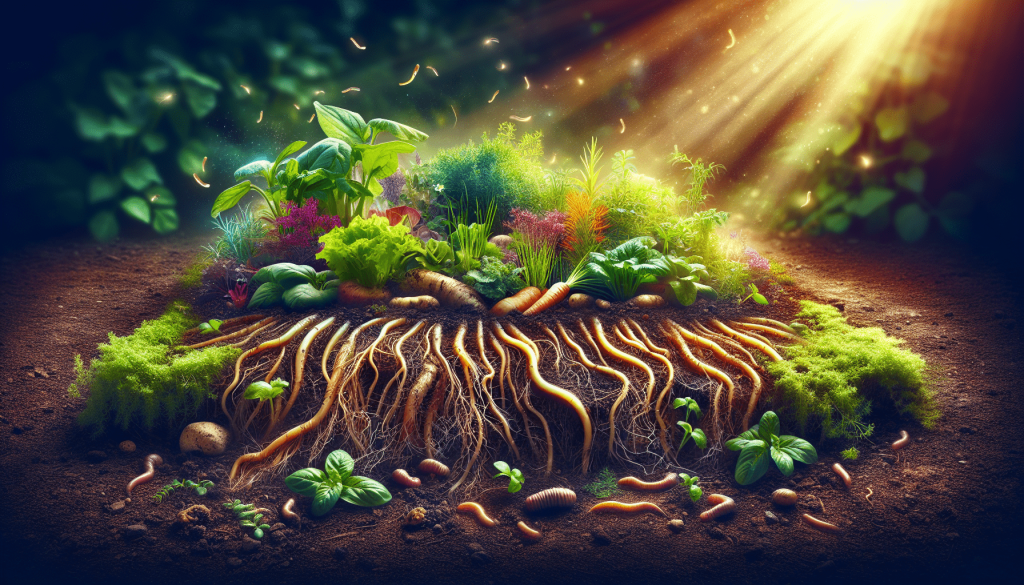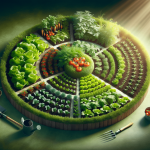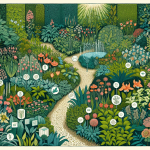This post may contain affiliate links. As an Amazon Associate, we may earn commissions from qualifying purchases.
In “How Does No-till Gardening Benefit Soil Health, And What Are The Potential Challenges And Solutions Associated With This Practice?” you’ll discover a friendly guide to understanding the transformation that no-till gardening can bring to your garden. You’ll learn how this practice can enhance soil health by preserving its structure, boosting microbial life, and reducing erosion. However, it’s not without its challenges, such as weed control and potential pest infestations. But don’t worry, you’ll also find practical solutions to overcome these hurdles, helping you cultivate a thriving and sustainable garden. Have you ever wondered why more and more gardeners are turning to no-till gardening techniques? It’s an interesting shift from traditional gardening methods, and you might be surprised to know just how many benefits it offers for soil health. In this article, we’ll dive deep into how no-till gardening can transform the way you interact with your garden soil. We’ll also address some potential challenges you might face when adopting this practice and offer solutions to help you make the most of it.
How Does No-till Gardening Benefit Soil Health?
No-till gardening is a method that avoids disturbing the soil through processes like plowing, digging, or tilling. Instead, organic matter is added to the soil surface, mirroring how nature builds soil layers over time. But why is this approach so beneficial for soil health? Let’s break it down.
Soil Structure Preservation
Tilling disrupts soil structure, leading to the collapse of natural soil aggregates. These aggregates are crucial because they create small pores that allow water, air, and roots to move through the soil easily. When you avoid tilling, you preserve these structures, which in turn promotes better root development and nutrient uptake.
Increased Organic Matter
In a no-till system, you continuously add organic matter such as compost, mulch, and cover crops to the soil surface. These organic layers decompose slowly, enriching the soil with nutrients over time. This not only improves soil fertility but also enhances its water retention capacity.
Enhanced Microbial Activity
Soil is teeming with life, including bacteria, fungi, and other microorganisms that play crucial roles in nutrient cycling and decomposition. Tilling can harm these microorganisms, disrupting their habitats and functions. No-till practices promote a robust microbial community, which in turn supports healthier plant growth.
Reduced Erosion
Soil erosion can be a significant problem in traditionally tilled gardens, especially on slopes. The root structures and organic matter in no-till gardens help stabilize the soil, reducing erosion by holding it in place and preventing runoff during heavy rains.
Improved Water Management
No-till gardens have better water infiltration and retention. The organic matter on the surface acts like a sponge, soaking up water and slowly releasing it into the soil. This is particularly beneficial in areas prone to drought, as it ensures that your plants have a steady water supply.
Carbon Sequestration
When you practice no-till gardening, you contribute to carbon sequestration by storing carbon in the soil. This helps in the fight against climate change by reducing the amount of carbon dioxide in the atmosphere.
Potential Challenges and Solutions in No-till Gardening
While no-till gardening offers numerous benefits, it does come with its own set of challenges. Here, we’ll explore the most common issues gardeners face when adopting no-till practices and offer practical solutions.
Initial Transition Period
Challenge:
Transitioning from a tilled to a no-till garden can be daunting. The soil might be compacted, and you might not see immediate improvements.
Solution:
Begin by adding generous amounts of organic matter, such as compost, to the soil surface. You might also consider starting with cover crops that can be left to decompose in place. Patience is key here, as it can take a few seasons for the soil to fully adjust to the new system.
Weed Control
Challenge:
Weeds can be a more significant problem in no-till gardens since you’re not disturbing the soil to bury weed seeds.
Solution:
Mulching heavily with organic materials like straw or wood chips can suppress weeds effectively. You can also use cover crops to outcompete weeds for resources and prevent them from taking hold. Hand-pulling can be necessary initially but becomes easier as the garden matures.
Pests and Diseases
Challenge:
With more organic material and residue on the soil surface, you might see an increase in pests and diseases.
Solution:
Diversity is your friend. Plant a variety of crops and use crop rotations to disrupt pest and disease cycles. Encourage beneficial insects by planting flowers and providing habitats for predators. Also, keeping your garden clean and removing diseased plant material can mitigate these problems.
Managing Residues
Challenge:
As crop residues accumulate, they can make planting new seeds or transplants tricky.
Solution:
Use a thick layer of mulch to manage residues more effectively. If residues are causing problems, consider lightly incorporating them into the top layer of the soil without fully turning it over. Over time, natural decomposition will make planting easier.
Soil Compaction
Challenge:
Especially in the initial stages, soil compaction can be an issue since you’re not tilling to break it up.
Solution:
Use deep-rooted cover crops like radishes or clovers to help break up compacted soil naturally. Adding organic matter will also help to loosen the soil structure over time.
Understanding No-till Tools
Challenge:
Adopting a no-till approach often requires a shift in the tools you use, which can be confusing.
Solution:
Familiarize yourself with no-till gardening tools such as broadforks for aerating the soil without turning it, and wheel hoes for managing weeds. Investing in good-quality tools designed for no-till gardening will make your job easier.

Practical Steps for Transitioning to No-till Gardening
If you’re ready to make the switch to no-till gardening, follow these step-by-step guidelines to ensure a smooth transition.
Step 1: Soil Testing
Before making changes, test your soil to understand its current health and composition. This will give you a baseline to measure your progress.
Step 2: Adding Organic Matter
Start by adding a thick layer of compost or organic mulch to the surface of your soil. The goal is to introduce beneficial organisms and nutrients.
Step 3: Planting Cover Crops
Plant cover crops that can help improve soil structure and fertility. Plants like clover, buckwheat, and vetch are excellent choices.
Step 4: Mulching
Use a thick layer of mulch to cover your garden beds. This helps protect the soil surface, retain moisture, and suppress weeds.
Step 5: Monitor and Adjust
Keep an eye on your garden’s progress. Check for compaction, weed growth, and pest issues. Adjust your practices as needed and be patient. Transforming your soil health is a gradual process.
Step 6: Incorporate Perennial Plants
Where possible, incorporate perennial vegetables and herbs. They help in maintaining soil structure and provide a constant cover.
Step 7: Practice Crop Rotation
Rotating crops every season minimizes pest and disease problems and helps maintain soil fertility.
Benefits of No-till Gardening: A Quick Recap
To help consolidate everything we’ve covered, let’s summarize the primary benefits of no-till gardening:
| Benefit | Description |
|---|---|
| Soil Structure | Preservation of soil aggregates, leading to better root development and nutrient uptake. |
| Organic Matter | Continuous addition of organic matter enriches the soil and enhances fertility and water retention. |
| Microbial Activity | Promotes a robust microbial community essential for nutrient cycling and plant health. |
| Erosion Control | Reduces soil erosion by stabilizing the soil with root structures and organic matter. |
| Water Management | Improves water infiltration and retention, providing a steady water supply to plants. |
| Carbon Sequestration | Helps store carbon in the soil, contributing to climate change mitigation. |

Overcoming Challenges: Practical Solutions Recap
Here’s a quick recap of the common challenges associated with no-till gardening and their solutions:
| Challenge | Solution |
|---|---|
| Initial Transition Period | Add organic matter and use cover crops; be patient as the soil adjusts. |
| Weed Control | Mulch heavily, use cover crops, and consider hand-pulling in the initial stages. |
| Pests and Diseases | Plant diverse crops, use crop rotation, encourage beneficial insects, and keep the garden clean. |
| Managing Residues | Use mulch to manage residues; lightly incorporate residues if necessary. |
| Soil Compaction | Grow deep-rooted cover crops and add organic matter to naturally loosen the soil. |
| Understanding No-till Tools | Familiarize yourself with specific no-till tools like broadforks and wheel hoes, and invest in quality equipment. |
Conclusion
Switching to no-till gardening is a rewarding journey that offers substantial benefits for soil health and overall garden productivity. While it comes with its own set of challenges, the solutions are practical and can be easily implemented. By preserving soil structure, increasing organic matter, enhancing microbial activity, reducing erosion, improving water management, and contributing to carbon sequestration, no-till gardening stands out as a sustainable, efficient, and environmentally friendly practice.
Are you ready to give no-till gardening a shot? It might just be the transformation your garden needs for healthier soil, more robust plants, and an eco-friendlier footprint. Happy gardening!








